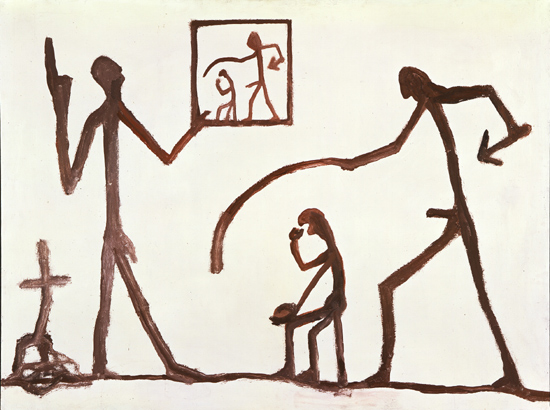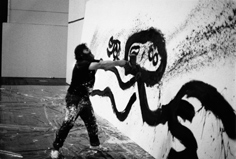A.R. Penck is at the forefront in reviving painting in contemporary German art. He has created a visual universe that has become widely reproduced, mixing pictorial signs and abstracted figures, at a crossroads between prehistoric painting and modern scientific iconography, adressing questions such as the Cold War, violence, art and science. In the first large survey held in Germany in the last twenty years, about 130 large-format paintings will be exhibited, along with objects and sculptures while a full section will be dedicated to a less-known aspect of his work: the artist books.
Beginnings in Dresden
A.R. Penck was born in Dresden, in the German Democratic Republic, in 1939 under another name: Ralf Winkler. He chose his pseudonym, which is still valid, in the early 1960s, making reference to the geologist Albrecht Penck (1858-1945). It has been assumed that this choice was a commentary on the Cold War (Albrecht Penck was a glaciation expert) and by the fascination the artist felt for the ice age cave paintings. Furthermore, A.R. Penck saw analogies between his art, which dealt closely with the treatment of information, and geology, both being organized in successive layers. Eager to find another path between traditional art and Socialist Realism, Penck created his famous stylized figures or « matchstick men » which he developed in his « Weltbilder » (World Pictures) from 1961 on.
A combination of abstraction and figuration
From the beginning, Penck was very attracted by the the concept of visual information that was developed in various fields of contemporary science and in particular in cybernetics. He experimented creating signs and symbols that could operate as a full system. In his « Standart-Bilder » (Standart pictures), he wanted to produce pictures, a combination of abstraction and figuration, immediately recognizable by any public that would see them. This approach was intended as an original contribution to socialism insofar as it would fit in a non-hierarchical discourse. Penck followed this path also in the creation of sculptures, made of painted cardboard, whose voluntarily poor aesthetics was reminiscent of Beuys and Fluxus.
Obsessed by the cold War
The smashing of the 1968 uprisings brought Penck, who was still living in Eastern Europe, back to one of his obsessive thematics : the Cold War. In the « Mike Hammer » and « TM » series, he produced pictures which were markedly more aggressive and expressive. He also worked in a large array of new media like video or wood sculptures. His numerous artist books, of which 70 will be exhibited, brought a widening of his personal universe, where the text becomes an element as essential as the painting itself. Unallowed to show his paintings in the GDR from 1962, Penck gathered momentum abroad : he was exhibited at the Venice Biennial and at the documenta.
Moving to the West
Penck was expatriated and moved to the West in 1980, to London and Dusseldorf where he held a professorship. He has been living in Dublin since he retired in 2003. This radical change affected his work which became more colourful, also favoured by his travels as in the work « Ereignis in New York » (Event in New York). However, it didn’t change the focus of his thematics which remained rooted in the East-West issue (he once said the East was a desert and the West a jungle) and the relationship between the individual and society.
Illustration: Benjamin Katz A.R. Penck bei der Entstehung von Quo vadis Germania, 1984.
Photo: B. Katz
CATALOGUE
« A.R. Penck Retrospektive ». Edited by Ingrid Pfeiffer and Max Hollein. With texts by Isabelle Graw, Harald Kunde, Ingrid Pfeiffer, Kevin Power, Pirkko Rathgeber, Jürgen Schweinebraden Freiherr zu Wichmann-Eichhorn. German and English edition, ca. 306 pages, ca. 336 color illustations, Richter Verlag GmbH Düsseldorf, ISBN 978-3-937572-68-0, 34 €.
| 








